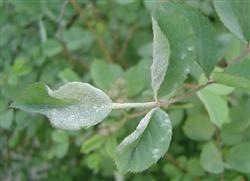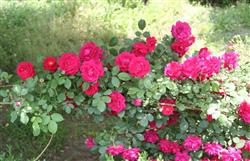Cultivation points of potted rose pomegranate

Rose pomegranate is a precious potted variety in the pomegranate family, its plant height is only 50 to 70 centimeters, but it has luxuriant branches and leaves, flowers and fruits. Moreover, as long as the winter temperature can be maintained above 5 ℃, it blossoms almost every day of the year, bearing fruit every month, full of flowers and fruits, which is very beautiful. Its red like fire, gorgeous and charming, fruity, sweet and sour delicious, set to watch, eat in one, very popular. 1. Sowing time. Seeds can be sowed and propagated in spring, summer and autumn. Seedlings should be raised in the greenhouse in early spring and late autumn. Whether it is raising seedlings in open field or in greenhouse, the temperature of seedling bed must be kept no higher than 25 ℃ in daytime and no less than 18 ℃ at night. 2. Sowing method. The pomegranate seed shell of rose is hard, and the seeds must be soaked in clean warm water below 40 ℃ for one day before sowing. After sowing, cover them with fine soil. Before emergence, the seedbed must be kept moist, not dry and wet. The temperature is high in summer, and the seedling bed is easy to dry and harden. after the seeds are sown, the seedling bed should not only keep moist, but also build a shade shed to avoid hot sun exposure and rainstorm erosion. After the seeds are sown, they can emerge one after another in half a month. 3. Transplanting management. The seedlings unearthed from Chinese rose pomegranate have a pair of green round cotyledons and pink stems. When the seedlings grow to 15 cm, they can take soil and transplant in the flowerpot. Generally choose a flowerpot with a diameter of 20 cm, one plant in a pot. The pot soil is well drained and fertile vegetable garden soil is mixed with a small amount of rotten cake fertilizer. When the seedling is 15 cm high, hit the tip and flat top, promote the branches, make the tree type low, full and luxuriant, and improve the ornamental value. Seedlings raised in early spring usually blossom from June to July of that year and bear fruit in autumn. Rose pomegranate for more than three years, with a plant height of 30cm and 40cm, each plant can fire nearly a hundred red flowers at the same time, hang dozens of fruits, a single fruit weighs 70mm 80g, a large fruit can reach 200g, flowers and fruits are the same tree, do not fall for a long time. The best growth temperature of rose pomegranate is 25 ℃, and it can withstand low temperature of about 5 ℃. Light frost can still blossom after autumn, but defoliation is dormant only after heavy frost. Rose pomegranate likes to be warm and sunny, the south can spend the winter outdoors naturally, and the north should move the flowerpot into the greenhouse to spend the winter. If we can take measures to protect against cold and heat preservation, we can still see the red flowers and fresh fruits full of trees in winter.
- Prev

How to prevent and cure powdery mildew of cut rose
Powdery mildew is one of the most important diseases of rose, which harms leaves, tender shoots, buds and pedicels. The control methods are as follows: strengthening cultivation management and timely removal of the disease; pruning in time to improve ventilation and light transmission conditions; nitrogen fertilizer should not be too much, it is necessary to increase the application of phosphorus and potassium fertilizer. 15% can be sprayed to prevent and cure the disease during the growing period.
- Next

Common insect pests of open rose
Rose is a flower with many insect pests. Before carrying out prevention and control, we should first understand the symptoms of insect pests and understand which kind of insect pests. Secondly, we should understand the occurrence time and regularity of this kind of insect pests, so as to prescribe the right medicine to the case. Here we introduce the four most common insect pests. Aphids gather on buds, tender leaves and flower buds of rose to suck.
Related
- Fuxing push coffee new agricultural production and marketing class: lack of small-scale processing plants
- Jujube rice field leisure farm deep ploughing Yilan for five years to create a space for organic food and play
- Nongyu Farm-A trial of organic papaya for brave women with advanced technology
- Four points for attention in the prevention and control of diseases and insect pests of edible fungi
- How to add nutrient solution to Edible Fungi
- Is there any good way to control edible fungus mites?
- Open Inoculation Technology of Edible Fungi
- Is there any clever way to use fertilizer for edible fungus in winter?
- What agents are used to kill the pathogens of edible fungi in the mushroom shed?
- Rapid drying of Edible Fungi

